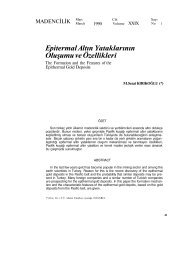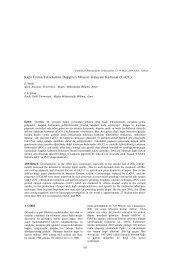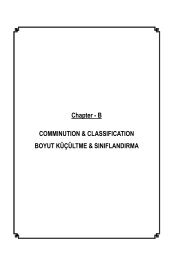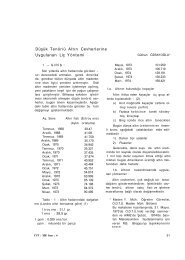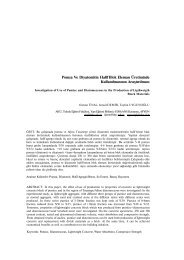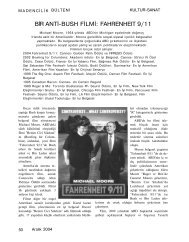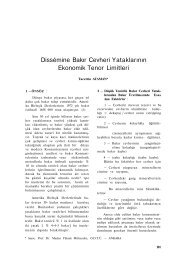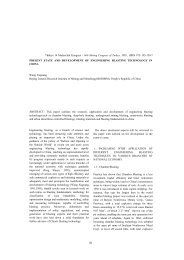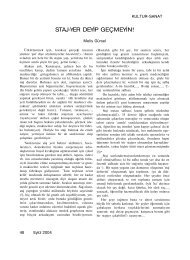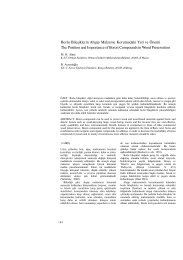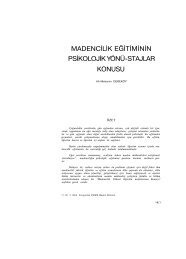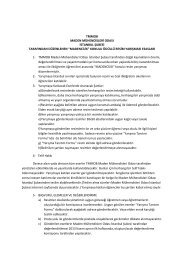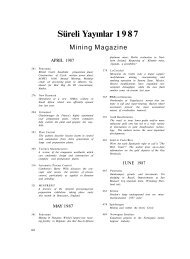A OPEN PIT MINING AÇIK OCAK MADENCİLİĞİ
A OPEN PIT MINING AÇIK OCAK MADENCİLİĞİ
A OPEN PIT MINING AÇIK OCAK MADENCİLİĞİ
You also want an ePaper? Increase the reach of your titles
YUMPU automatically turns print PDFs into web optimized ePapers that Google loves.
23 rd <br />
Gold-Mining and Ornamental Stones Quarrying in The Wadi<br />
Hammamat, Ancient Egypt: Geological Framework and<br />
Techniques<br />
M. Coli & M. Baldi<br />
Dip. Scienze della Terra, UNIFI - Italy<br />
ABSTRACT In this paper we outline the cultural and technical context and the geological<br />
framework of the outstanding gold mining and prized ornamental stone quarrying activities<br />
which were carried out in the Wadi Hammamat (‘Valley of the Baths’) in Ancient Egypt.<br />
Quarrying and mining remains preserve traces of man’s activity and of technical skill,<br />
therefore they represent “landscape archives” and valuable cultural heritage sites where the<br />
traces of work, technology, organization and social life can be studied in order to hand them<br />
down to posterity and open a window on an ancient world, almost unknown to most. The<br />
results of our survey confirm the correctness of ancient geological knowledge as shown in the<br />
famous Turin Mine Papyrus, and in general highlight a good knowledge of the territory, such<br />
as the role played by the geological setting in providing materials and driving the extraction<br />
techniques, both in the Pharaonic and Roman periods.<br />
1 INTRODUCTION<br />
From ancient times until today the use of<br />
natural stone and mine resources has been a<br />
main element for human activity. Historical<br />
extraction sites have been lately described as<br />
“landscape archives”: sites or areas where<br />
the traces of work, technology, organization<br />
and social life are preserved and where they<br />
can be studied in order to hand them down to<br />
posterity and open a window on an ancient<br />
world, almost unknown to most.<br />
In the last decades there was a renewed<br />
interest for ancient quarry and mine<br />
exploitation in the scientific community,<br />
public administrations and in the area of the<br />
cultural tourism. Several cultural activities<br />
have grown based on a rediscovery and<br />
reappraisal of ancient quarries and mines,<br />
such as the creation of eco-museums and<br />
other didactic activities at various levels.<br />
The study of the historical quarrying and<br />
mining sites highlights the diffusion of a<br />
shared basic knowledge among ancient<br />
civilizations and the fact that technologies<br />
were strictly linked to the social and cultural<br />
aspects of each population.<br />
At the same time these recent studies<br />
outline both a good knowledge of the<br />
territory and of its geological setting which<br />
was used at the best in developing the right<br />
exploitation techniques. That was<br />
particularly true in Ancient Egypt (Arnold,<br />
1991; Aufrère, 1991).<br />
The Wadi Hammamat represents a<br />
“landscape archive” where it is possible to<br />
study the ancient quarrying and mining<br />
processes and the social and geological<br />
knowledge context in which these processes<br />
where developed.<br />
Previous studies (Ortolani, 1989; Arnold,<br />
1991; Klemm & Klemm, 1993/2008; Meyer,<br />
9



